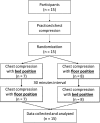Effect of chest compression with kneeling on the bed in clinical situations
- PMID: 31957258
- PMCID: PMC7189814
- DOI: 10.1111/jjns.12314
Effect of chest compression with kneeling on the bed in clinical situations
Abstract
Aim: Cardiopulmonary resuscitation is vital for survival after cardiac arrest, and chest compressions are an important aspect of this. When performing chest compression in a hospital setting, the rescuer often has to kneel on the bed to overcome inconvenient differences in height between the rescuer and the bed. However, as yet no study has evaluated the quality of chest compressions in this position. The aim of this study was to examine the impact on the quality of chest compressions while kneeling on the bed.
Methods: Fifteen female students performed 2-min chest compressions on a manikin placed on the floor and a bed. Measurement parameters included compression depth, heart rate, integrated electromyogram, and a visual analog scale. The parameters were measured every 30 s and were statistically compared between the conditions.
Results: Compression depth at 30, 60, 90, and 120 s differed significantly between the conditions. Heart rate values at 150 and 210 s of recovery significantly differed between the conditions. Integrated electromyogram values for the trapezius, rectus femoris, and biceps femoris differed between the floor and bed conditions during 2-min chest compressions, whereas the external oblique muscle significantly differed at 60 and 120 s. Visual analog scales for fatigue, effectiveness, and stability significantly differed between the conditions.
Conclusion: Kneeling on the bed does not enable grounding of the toe, causing the upper body to be unstable and limiting generation of the power required for chest compression. Our results suggest that rotation every minute is necessary to maintain effective cardiopulmonary resuscitation while kneeling on the bed.
Keywords: cardiopulmonary resuscitation; chest compression; fatigue; grounding toe; rescuer's position.
© 2019 The Authors Japan Journal of Nursing Science published by John Wiley & Sons Australia, Ltd on behalf of Japan Academy of Nursing Science.
Conflict of interest statement
There are no conflicts of interest to disclose.
Figures







References
-
- Abella, B. S. , Sandbo, N. , Vassilatos, P. , Alvarado, J. P. , O'Hearn, N. , Wigder, H. N. , … Becker, L. B. (2005a). Chest compression rates during cardiopulmonary resuscitation are suboptimal: A prospective study during in‐hospital cardiac arrest. Circulation, 111, 428–434. - PubMed
-
- Abella, B. S. , Alvarado, J. P. , Myklebust, H. , Edelson, D. P. , Barry, A. , O'Hearn, N. , … Becker, L. B. (2005b). Quality of cardiopulmonary resuscitation during in‐hospital cardiac arrest. The Journal of the American Medical Association, 293, 305–310. - PubMed
-
- Berg, R. A. , Hemphill, R. , Abella, B. S. , Aufderheide, T. P. , Cave, D. M. , Hazinski, M. F. , … Swor, R. A. (2010). Part 5: Adult basic life support: 2010 American Heart Association guidelines for cardiopulmonary resuscitation and emergency cardiovascular care. Circulation, 122, S685–S705. - PubMed
-
- Handley, A. J. , & Handley, J. A. (2004). Performing chest compressions in a confined space. Resuscitation, 61, 55–61. - PubMed
MeSH terms
Grants and funding
LinkOut - more resources
Full Text Sources
Medical

